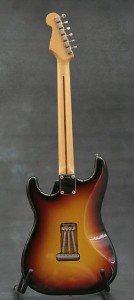
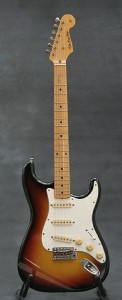 Tokai Stratocaster Custom Edition made in Japan, je replikou originálního '54-'56 Fender Stratocasteru s 7-1/2" radiusem U-tvarovaného javorového krku, typickým kruhovým srážečem strun na hlavě kytary a se speciálním Tokai logem pro Custom Edition. Tento Tokai Strat byl vyroben v roce
Tokai Stratocaster Custom Edition made in Japan, je replikou originálního '54-'56 Fender Stratocasteru s 7-1/2" radiusem U-tvarovaného javorového krku, typickým kruhovým srážečem strun na hlavě kytary a se speciálním Tokai logem pro Custom Edition. Tento Tokai Strat byl vyroben v roce 1986 a jedná se o opravdu povedený kousek, dokonalou repliku originálních USA Fender Stratů z 50-tých let, stejně kvalitní provedení nástroje a hlavně skvělá řemeslná práce. Tento Tokai je profesionální nástroj bez vad a kompromisů a nabízí tradiční a pravý Pre-CBS zvuk jako mají mega-drahé originální vintage stratocastery. Tělo tohoto Tokai Strat Cu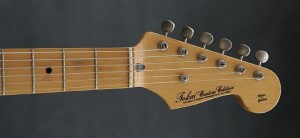 stom Edition je vyrobeno z olše a finiš je tří tónový sunburst, černá, červená a žlutá. Provedení sunburstu a finiš kytary je stejně kvalitní a bezchybně provedený jako u Fender Custom Shop kytar s viditelnou strukturou kresby dřeva pod finální úpravou nástroje. Stratocaster je jedna z nejlepších kytar kdy postavených, takže i vybavení tohoto Tokai Stratu nabízí hráči vše potřebné. Tyto kytary Tokai byly stavěny jako špičkové profesionální nástroje a tento exemplář je ve skvělé celkové kondici.
stom Edition je vyrobeno z olše a finiš je tří tónový sunburst, černá, červená a žlutá. Provedení sunburstu a finiš kytary je stejně kvalitní a bezchybně provedený jako u Fender Custom Shop kytar s viditelnou strukturou kresby dřeva pod finální úpravou nástroje. Stratocaster je jedna z nejlepších kytar kdy postavených, takže i vybavení tohoto Tokai Stratu nabízí hráči vše potřebné. Tyto kytary Tokai byly stavěny jako špičkové profesionální nástroje a tento exemplář je ve skvělé celkové kondici.  Tokai má 21 pražců a krk je vyroben z jednoho kusu výběrového javoru s 7-1/2" radiusem a U-tvarováním krku, který je tak příjemně kulatý do ruky s nezbytným „tchořím pruhem“ zezadu pro výztuhu. Krk je rovný, precizně seřízený s příjemným dohmatem a se 100%stavem pražců, zkrátka nástroj připravený pro kvalitní hraní. Kytara
Tokai má 21 pražců a krk je vyroben z jednoho kusu výběrového javoru s 7-1/2" radiusem a U-tvarováním krku, který je tak příjemně kulatý do ruky s nezbytným „tchořím pruhem“ zezadu pro výztuhu. Krk je rovný, precizně seřízený s příjemným dohmatem a se 100%stavem pražců, zkrátka nástroj připravený pro kvalitní hraní. Kytara 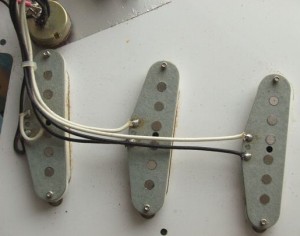 má samozřejmě bezchybnou intonaci po celé délce hmatníku krku. Ladící mechanika je Tokai Deluxe Kluson-styl, tedy asi ta nejlepší mechanika pro Stratocaster vůbec. Mechanika ladí a drží bezvadně a je společně s Fender tremolem tou největší klasikou všech vintage stratocasterů. Snímače a elektronika jsou plně originální ve 100% stavu. Tokai snímače jsou s legendárním šedým spodkem a jsou považovány za jedny z nejbližších originálním Pre-CBS Fender singlům z 50-tých let co se zvuku i vzhledu týče. Elektronika je originální Tokai cloth wired a tří-polohový přepínač byl vyměněn za pěti-polohový, takže hráč může přepnout až 5 kombinací snímačů.
má samozřejmě bezchybnou intonaci po celé délce hmatníku krku. Ladící mechanika je Tokai Deluxe Kluson-styl, tedy asi ta nejlepší mechanika pro Stratocaster vůbec. Mechanika ladí a drží bezvadně a je společně s Fender tremolem tou největší klasikou všech vintage stratocasterů. Snímače a elektronika jsou plně originální ve 100% stavu. Tokai snímače jsou s legendárním šedým spodkem a jsou považovány za jedny z nejbližších originálním Pre-CBS Fender singlům z 50-tých let co se zvuku i vzhledu týče. Elektronika je originální Tokai cloth wired a tří-polohový přepínač byl vyměněn za pěti-polohový, takže hráč může přepnout až 5 kombinací snímačů. 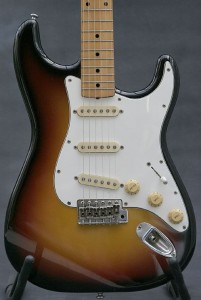
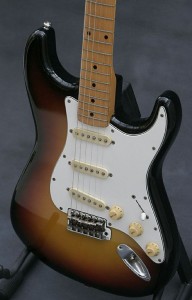 Je samozřejmě velmi snadné tento 3 polohový přepínač vyměnit kdykoliv za pěti polohový, tedy dle gusta hráče. Dnes jsou tyto staré Tokai kytary předmětem celosvětového zájmu a Tokai Custom Edition '54-'56 stratocaster je hodnocen jako mnohem zdařilejší a pečlivěji provedený nástroj než modely Goldstar nebo Springy sound.
Je samozřejmě velmi snadné tento 3 polohový přepínač vyměnit kdykoliv za pěti polohový, tedy dle gusta hráče. Dnes jsou tyto staré Tokai kytary předmětem celosvětového zájmu a Tokai Custom Edition '54-'56 stratocaster je hodnocen jako mnohem zdařilejší a pečlivěji provedený nástroj než modely Goldstar nebo Springy sound. 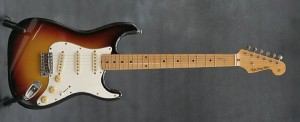

 Tokai Strat Custom Edition a copy of a '54-'56 Fender Stratocaster with 7-1/2" radius U-shaped maple neck with typical round string tree on a peghead with a custom edition strat scroll type logo. This Tokai strat is as good as any American Fender from the same period, it has excellent build quality and sounds fantastic. The Alder body finished in yellow sunburst, three colors, black, red and yellow. The Sunburst finish is as good as any Custom Shop with the beautifully grained body showing through. The Strat is the finest guitar ever built, so the features are all you need in a guitar. These Tokais were built as top quality pro instruments. This one is in very good condition, the neck is straight with low action and good frets and it's very
Tokai Strat Custom Edition a copy of a '54-'56 Fender Stratocaster with 7-1/2" radius U-shaped maple neck with typical round string tree on a peghead with a custom edition strat scroll type logo. This Tokai strat is as good as any American Fender from the same period, it has excellent build quality and sounds fantastic. The Alder body finished in yellow sunburst, three colors, black, red and yellow. The Sunburst finish is as good as any Custom Shop with the beautifully grained body showing through. The Strat is the finest guitar ever built, so the features are all you need in a guitar. These Tokais were built as top quality pro instruments. This one is in very good condition, the neck is straight with low action and good frets and it's very  comfortable to play. This instrument has 21 vintage style frets on chunky one-piece maple U-shaped neck slightly rounded with a skunk stripe. The guitar has perfect intonation and the neck is unbelievably playable and just perfect. The tuners are Tokai
comfortable to play. This instrument has 21 vintage style frets on chunky one-piece maple U-shaped neck slightly rounded with a skunk stripe. The guitar has perfect intonation and the neck is unbelievably playable and just perfect. The tuners are Tokai  'Klusons' which are the nicest looking for Stratocaster style guitars ever used. The Kluson style tuners work perfectly and the trem is typical of all Fender vintage setups. The pickups, switches and electronics are all working fine. The Tokai grey backed pick ups are said to be the closest you will get to pre-CBS Fender! The pickups are original, cloth wired
'Klusons' which are the nicest looking for Stratocaster style guitars ever used. The Kluson style tuners work perfectly and the trem is typical of all Fender vintage setups. The pickups, switches and electronics are all working fine. The Tokai grey backed pick ups are said to be the closest you will get to pre-CBS Fender! The pickups are original, cloth wired  Tokai, and are great! There are no ID markings on the base of the pickups but they are perfect. The sounds and tone got from clean to dirty. Typical strat controls, all original, 3 position mechanical selector switch which has mini-detents in the 2 and 4 positions. You can "kind of" feel them when you are switching just like a vintage original. Overall, incredible. Had my eye on these guitars for many years and getting harder and harder to find. This particular one is a real prize. Im currently using extremely expensive Fender Custom Shop ´54 Strat and this one falls right in line with him. It plays and feels and sounds like the real thing. The sound of this guitar is very particular - it's bright and chimey. I should also mention that guitar stays i
Tokai, and are great! There are no ID markings on the base of the pickups but they are perfect. The sounds and tone got from clean to dirty. Typical strat controls, all original, 3 position mechanical selector switch which has mini-detents in the 2 and 4 positions. You can "kind of" feel them when you are switching just like a vintage original. Overall, incredible. Had my eye on these guitars for many years and getting harder and harder to find. This particular one is a real prize. Im currently using extremely expensive Fender Custom Shop ´54 Strat and this one falls right in line with him. It plays and feels and sounds like the real thing. The sound of this guitar is very particular - it's bright and chimey. I should also mention that guitar stays i n
n tune quite well, and that the neck rarely needs adjusting. Tokai Strat Limited Edition made 1986 - crafted in 3 Tone Sunburst - Maple Neck - Deluxe Stamped Tuners - Final Prospec Saddles - Aged Pickup Covers & Knobs - Tokai Grey Bottom Pickups. Old Tokai guitars seem to be getting collectible now and this Tokai Custom Edition is even more rare than a Goldstar or Springy sound. I love everything about this strat, it "feels" like a custom shop Fender!
tune quite well, and that the neck rarely needs adjusting. Tokai Strat Limited Edition made 1986 - crafted in 3 Tone Sunburst - Maple Neck - Deluxe Stamped Tuners - Final Prospec Saddles - Aged Pickup Covers & Knobs - Tokai Grey Bottom Pickups. Old Tokai guitars seem to be getting collectible now and this Tokai Custom Edition is even more rare than a Goldstar or Springy sound. I love everything about this strat, it "feels" like a custom shop Fender!
NOTE:
Fender and Gibson, the two companies who more than any others fueled the rise of the electric guitar in American popular culture, had by the dawn of the 70's lost their way. The ascension in the 60's of the guitar as the tentpole instrument of popular music had attracted the notice of corporate beancounters who stepped in to claim a piece of the action but knew nothing about the soul of either the product or its buyers.
What followed was a steady slide into mediocrity in which the hallowed Fender and Gibson brand names were milked by their respective new corporate owners, CBS and Norlin, for all they were worth. Both the quality of the companies' products and their reputations suffered as a result. By the early 1980's, buyers had learned that there were other and better sources for their new instrument needs.
New, smarter and better-attuned management teams took control of Fender and Gibson by the mid-80's enabling both companies in the ensuing years to reverse the downward spiral. In each case, the turnaround was fueled by a return to the guitars that made the brands powerful in the first place, the classic electrics of the 50's and 60's.
But both Fender and Gibson, in their plodding mega-corporate days, had been slow on the uptake. When the first age of the 'Guitar God' in the mid-60's fueled buyers' interest in the guitars that Mike Bloomfield and Eric Clapton and Jeff Beck and Jimmy Page played, Fender and Gibson watched from the sidelines as their 'downscale' and 'unsuccessful' products of an earlier era, now changing hands only in the used marketplace, became the guitars that everyone wanted to own -- vintage Strats and Teles and Les Pauls.
This market phenomenon, while it sailed over the heads of the befuddled corporate overlords running Gibson and Fender, did not go unnoticed in Japan.
Whereas many of the first Japanese electric guitars to reach Western markets in the early-to-mid 60's were cheap, entry-level caricatures designed to capture a sliver of the burgeoning electric guitar market, in the process the production mechanisms of Japanese guitar makers were being refined and their market was steadily growing. In Japan, where appreciation of American popular culture was then and is now widespread, the original Gibsons and Fenders were hard to find and prohibitively expensive. So by the end of the 60's, companies like Fuji Gen Gakki and Tokai Gakki began creating fairly faithful replicas of the vintage-style Les Pauls and Strats and Teles that the marketplace had come to crave.
While in the US Fender and Gibson thrashed around with 'updated' and 'contemporized' versions of their signature guitars that left most buyers cold, the Japanese guitar makers knew what they were going for and with steadily increasing frequency nailed it. Marketed under names like Tokai and Ibanez and Greco and Burny and Fernandes, these 'copy' guitars by the late-'70s had attained an astonishing degree of fidelity to the original instruments they were copying. They looked right and played right and sounded right. So right that they were cutting deeply into the sale of Fender and Gibson's new products in Japan and throughout Asia.
When these 'copy' guitars began appearing in the United States, Gibson's parent Norlin moved to blunt the attack by suing the US distributor for Hoshino, the Japanese company marketing the Ibanez guitars made by Fuji Gen Gakki, for trademark infringement, the trademarked component in this case being the 'open book' headstock shape of Gibson's guitars. Thus was christened the 'lawsuit' designation applied broadly to an entire class of Japanese guitars which, in truth, were so close to the originals that they easily crossed the line into in-your-face infringement.
When in the early 80's it finally dawned on the corporate overlords at CBS that they were well on the way to running Fender's reputation and sales into the ground, they moved to stanch the hemorrhage by bringing in a new Fender management team recruited from the Japanese multinational corporation Yamaha's USA operation.
The new team set about studying ways of bringing Fender back from the precipice. Taking a cue from the success of the Japanese 'copy' guitars, they included in their plan of attack a return to the guitars that had made the company's reputation in the first place -- the classic Stratocasters and Telecasters of the 1950's and early 1960's. And so began the American vintage reissue series -- the 1952 and 1962 Telecaster reissues and the Stratocaster reissues based on the original 1954, 1957 and 1962 models.
To do battle in the Asian market with the Strat and Tele clones that had heavily damaged Fender's sales, another initiative was begun to fight the copycats on their own turf. Fender launched a Japan-based manufacturing operation licensed to create and market guitars using not only the classic Fender designs but bearing the Fender name. And so Fender Japan was born.
When the American Fender team visited Japan to see how their counterparts were faring in the effort to capture the magic that had made vintage Fender guitars so special, they made a startling discovery. As Dan Smith, head of Fender USA marketing, was quoted in Tony Bacon and Paul Day's excellent THE FENDER BOOK, "Everybody came up to inspect them and the guys almost cried, because the Japanese product was so good - it was what we had been having a hell of a time trying to do."
Why did two famous American companies decide to put their names on products made in Japan? Beyond an expedient reaction to market pressures, the reasons were shrewdly tied into the make-up of 'the Japanese character' as a people and a nation.
Before the licensing deals were struck, Japanese replicas of classic Fender and Gibson guitars had proven themselves to be very well-made instruments. The dedication of Japanese workers and the excellence of Japanese products had by that time become apparent to the world, as Japan's dominance in automobile and electronics manufacture, for example, had made abundantly clear. It came as no surprise, then, that manufacturing standards in guitar-making would be similarly advanced.
Japan's culture is one in which duty, team contribution and the idea of work done correctly is a given. There is no 'Friday Phenomenon' in Japan's factories, where goods produced at the end of the work week are susceptible to careless assembly because the workers' minds are elsewhere. One does what one does to the absolute best of one's ability, always. It's a matter of personal honor.
Which brings us to the second reason why Fender and Gibson decided to put their names on Japanese-made guitars. While there are certainly aspects of American life that some Japanese find baffling or unsettling, by and large many are fascinated by the icons of American popular culture. Certain brand names, especially, are viewed with a type of reverence. Fender and Gibson guitars, so closely entwined with visions of America and American popular culture, are very much among those revered icons in Japan.
When Japanese luthiers set out to replicate the guitars that made Fender and Gibson great, only the most naive could think that their efforts would be anything less than impressive. Here we have an individual mindset and production mechanism geared toward work of unerring quality combined with an item to be made which excites reverence in the maker. If that isn't a recipe for successful manufacturing venture, a better one would be hard to imagine.
Guitargai – Luthiers, knows that not everybody wants to spend a fortune to buy a great guitar. While many US-made electrics from the '50s and '60s are in fact great guitars, their highly-inflated market value hinges not on their individual greatness but on their collective rarity.
Those guitargai offers players and collectors alike an array of great guitars which look, sound and play like the vintage originals, made with fanatical attention to detail and unerring quality by the finest guitarmakers of Japan. Quality so uncompromising that Fender and Gibson have put their names and reputations on them.
Japan guitars, the reissues especially, have over the years provided knowing musicians with great quality and value at a relatively modest price, until just a few years ago co-existing in the US marketplace with their more-expensive American Fender cousins.
The higher-end Japan models, in which the dictates of price-point have been discarded in favor of creating the highest-quality guitar possible, rival and can even surpass the best examples of Fender USA Custom Shop work.
Tokai Strat Custom Edition a copy of a '54-'56 Fender Stratocaster with 7-1/2" radius U-shaped maple neck with typical round string tree on a peghead with a custom edition strat scroll type logo. This Tokai strat is as good as any American Fender from the same period, it has excellent build quality and sounds fantastic. The Alder body finished in yellow sunburst, three colors, black, red and yellow. The Sunburst finish is as good as any Custom Shop with the beautifully grained body showing through. The Strat is the finest guitar ever built, so the features are all you need in a guitar. These Tokais were built as top quality pro instruments. This one is in very good condition, the neck is straight with low action and good frets and it's very
comfortable to play. This instrument has 21 vintage style frets on chunky one-piece maple U-shaped neck slightly rounded with a skunk stripe. The guitar has perfect intonation and the neck is unbelievably playable and just perfect. The tuners are Tokai
'Klusons' which are the nicest looking for Stratocaster style guitars ever used. The Kluson style tuners work perfectly and the trem is typical of all Fender vintage setups. The pickups, switches and electronics are all working fine. The Tokai grey backed pick ups are said to be the closest you will get to pre-CBS Fender! The pickups are original, cloth wired
Tokai, and are great! There are no ID markings on the base of the pickups but they are perfect. The sounds and tone got from clean to dirty. Typical strat controls, all original, 3 position mechanical selector switch which has mini-detents in the 2 and 4 positions. You can "kind of" feel them when you are switching just like a vintage original. Overall, incredible. Had my eye on these guitars for many years and getting harder and harder to find. This particular one is a real prize. Im currently using extremely expensive Fender Custom Shop ´54 Strat and this one falls right in line with him. It plays and feels and sounds like the real thing. The sound of this guitar is very particular - it's bright and chimey. I should also mention that guitar stays i
n
tune quite well, and that the neck rarely needs adjusting. Tokai Strat Limited Edition made 1986 - crafted in 3 Tone Sunburst - Maple Neck - Deluxe Stamped Tuners - Final Prospec Saddles - Aged Pickup Covers & Knobs - Tokai Grey Bottom Pickups. Old Tokai guitars seem to be getting collectible now and this Tokai Custom Edition is even more rare than a Goldstar or Springy sound. I love everything about this strat, it "feels" like a custom shop Fender!
NOTE:
Fender and Gibson, the two companies who more than any others fueled the rise of the electric guitar in American popular culture, had by the dawn of the 70's lost their way. The ascension in the 60's of the guitar as the tentpole instrument of popular music had attracted the notice of corporate beancounters who stepped in to claim a piece of the action but knew nothing about the soul of either the product or its buyers.
What followed was a steady slide into mediocrity in which the hallowed Fender and Gibson brand names were milked by their respective new corporate owners, CBS and Norlin, for all they were worth. Both the quality of the companies' products and their reputations suffered as a result. By the early 1980's, buyers had learned that there were other and better sources for their new instrument needs.
New, smarter and better-attuned management teams took control of Fender and Gibson by the mid-80's enabling both companies in the ensuing years to reverse the downward spiral. In each case, the turnaround was fueled by a return to the guitars that made the brands powerful in the first place, the classic electrics of the 50's and 60's.
But both Fender and Gibson, in their plodding mega-corporate days, had been slow on the uptake. When the first age of the 'Guitar God' in the mid-60's fueled buyers' interest in the guitars that Mike Bloomfield and Eric Clapton and Jeff Beck and Jimmy Page played, Fender and Gibson watched from the sidelines as their 'downscale' and 'unsuccessful' products of an earlier era, now changing hands only in the used marketplace, became the guitars that everyone wanted to own -- vintage Strats and Teles and Les Pauls.
This market phenomenon, while it sailed over the heads of the befuddled corporate overlords running Gibson and Fender, did not go unnoticed in Japan.
Whereas many of the first Japanese electric guitars to reach Western markets in the early-to-mid 60's were cheap, entry-level caricatures designed to capture a sliver of the burgeoning electric guitar market, in the process the production mechanisms of Japanese guitar makers were being refined and their market was steadily growing. In Japan, where appreciation of American popular culture was then and is now widespread, the original Gibsons and Fenders were hard to find and prohibitively expensive. So by the end of the 60's, companies like Fuji Gen Gakki and Tokai Gakki began creating fairly faithful replicas of the vintage-style Les Pauls and Strats and Teles that the marketplace had come to crave.
While in the US Fender and Gibson thrashed around with 'updated' and 'contemporized' versions of their signature guitars that left most buyers cold, the Japanese guitar makers knew what they were going for and with steadily increasing frequency nailed it. Marketed under names like Tokai and Ibanez and Greco and Burny and Fernandes, these 'copy' guitars by the late-'70s had attained an astonishing degree of fidelity to the original instruments they were copying. They looked right and played right and sounded right. So right that they were cutting deeply into the sale of Fender and Gibson's new products in Japan and throughout Asia.
When these 'copy' guitars began appearing in the United States, Gibson's parent Norlin moved to blunt the attack by suing the US distributor for Hoshino, the Japanese company marketing the Ibanez guitars made by Fuji Gen Gakki, for trademark infringement, the trademarked component in this case being the 'open book' headstock shape of Gibson's guitars. Thus was christened the 'lawsuit' designation applied broadly to an entire class of Japanese guitars which, in truth, were so close to the originals that they easily crossed the line into in-your-face infringement.
When in the early 80's it finally dawned on the corporate overlords at CBS that they were well on the way to running Fender's reputation and sales into the ground, they moved to stanch the hemorrhage by bringing in a new Fender management team recruited from the Japanese multinational corporation Yamaha's USA operation.
The new team set about studying ways of bringing Fender back from the precipice. Taking a cue from the success of the Japanese 'copy' guitars, they included in their plan of attack a return to the guitars that had made the company's reputation in the first place -- the classic Stratocasters and Telecasters of the 1950's and early 1960's. And so began the American vintage reissue series -- the 1952 and 1962 Telecaster reissues and the Stratocaster reissues based on the original 1954, 1957 and 1962 models.
To do battle in the Asian market with the Strat and Tele clones that had heavily damaged Fender's sales, another initiative was begun to fight the copycats on their own turf. Fender launched a Japan-based manufacturing operation licensed to create and market guitars using not only the classic Fender designs but bearing the Fender name. And so Fender Japan was born.
When the American Fender team visited Japan to see how their counterparts were faring in the effort to capture the magic that had made vintage Fender guitars so special, they made a startling discovery. As Dan Smith, head of Fender USA marketing, was quoted in Tony Bacon and Paul Day's excellent THE FENDER BOOK, "Everybody came up to inspect them and the guys almost cried, because the Japanese product was so good - it was what we had been having a hell of a time trying to do."
Why did two famous American companies decide to put their names on products made in Japan? Beyond an expedient reaction to market pressures, the reasons were shrewdly tied into the make-up of 'the Japanese character' as a people and a nation.
Before the licensing deals were struck, Japanese replicas of classic Fender and Gibson guitars had proven themselves to be very well-made instruments. The dedication of Japanese workers and the excellence of Japanese products had by that time become apparent to the world, as Japan's dominance in automobile and electronics manufacture, for example, had made abundantly clear. It came as no surprise, then, that manufacturing standards in guitar-making would be similarly advanced.
Japan's culture is one in which duty, team contribution and the idea of work done correctly is a given. There is no 'Friday Phenomenon' in Japan's factories, where goods produced at the end of the work week are susceptible to careless assembly because the workers' minds are elsewhere. One does what one does to the absolute best of one's ability, always. It's a matter of personal honor.
Which brings us to the second reason why Fender and Gibson decided to put their names on Japanese-made guitars. While there are certainly aspects of American life that some Japanese find baffling or unsettling, by and large many are fascinated by the icons of American popular culture. Certain brand names, especially, are viewed with a type of reverence. Fender and Gibson guitars, so closely entwined with visions of America and American popular culture, are very much among those revered icons in Japan.
When Japanese luthiers set out to replicate the guitars that made Fender and Gibson great, only the most naive could think that their efforts would be anything less than impressive. Here we have an individual mindset and production mechanism geared toward work of unerring quality combined with an item to be made which excites reverence in the maker. If that isn't a recipe for successful manufacturing venture, a better one would be hard to imagine.
Guitargai – Luthiers, knows that not everybody wants to spend a fortune to buy a great guitar. While many US-made electrics from the '50s and '60s are in fact great guitars, their highly-inflated market value hinges not on their individual greatness but on their collective rarity.
Those guitargai offers players and collectors alike an array of great guitars which look, sound and play like the vintage originals, made with fanatical attention to detail and unerring quality by the finest guitarmakers of Japan. Quality so uncompromising that Fender and Gibson have put their names and reputations on them.
Japan guitars, the reissues especially, have over the years provided knowing musicians with great quality and value at a relatively modest price, until just a few years ago co-existing in the US marketplace with their more-expensive American Fender cousins.
The higher-end Japan models, in which the dictates of price-point have been discarded in favor of creating the highest-quality guitar possible, rival and can even surpass the best examples of Fender USA Custom Shop work.
Náhledy fotografií ze složky Tokai Strat Custom Edition

